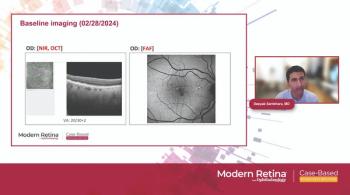
New research data reflect patient satisfaction following faricimab treat-and-extend regimen
A retrospective observational study shows BCVA was maintained after 6 months for patients with neovascular AMD.
A Japanese study found that switching to faricimab (Vabysmo, Genentech) treatment using a treat-and-extend (TAE) regimen seems to maintain the best-corrected visual acuity (BCVA) and extend the injection interval in patients with neovascular age-related macular degeneration (nAMD), resulting in enhanced satisfaction 6 months after patients were switched.1 Taiichi Hikichi, MD, who is in private practice in Sapporo, Japan, reported his findings in the Japanese Journal of Ophthalmology.
Hikichi conducted a retrospective observational study of 48 consecutive eyes of 48 patients with nAMD who were switched to faricimab and followed for 6 months while they were on a TAE regimen. At the 6-month time point, the patients completed the Macular Disease Treatment Satisfaction Questionnaire (MacTSQ).
The results showed that the BCVA was maintained 6 months after the patients were switched to the faricimab TAE regimen. In addition, the mean central foveal thickness decreased significantly (p < 0.001) at 6 months compared to the time at which patients started on faricimab from 372 ± 20 μm to 272 ± 14 μm.
The treatment interval following the switch was 10.45 ± 0.44 weeks, which differed significantly (p = 0.002) from the treatment interval of 6.72 ± 0.34 weeks at the time of the switch.
Hikichi also reported that the MacTSQ total score of 58.8 ± 1.7 in eyes with a BCVA of 20/40 and better 6 months after the switch was significantly (p < 0.001). higher compared to that in eyes with a BCVA worse than 20/40 (48.2 ± 1.5). The MacTSQ total score of 56.8 ± 1.8 in eyes in which a 4-week extension of the injection interval was achieved was significantly higher than the 49.5 ± 1.9 in eyes without (p < 0.001).
He concluded that switching to faricimab administered using a TAE regimen seems to maintain the BCVA and extend the injection interval in patients with nAMD, resulting in enhanced patient satisfaction.
Reference
1. Hikichi T. Investigation of satisfaction with short-term outcomes after switching to faricimab to treat neovascular age-related macular degeneration. Jpn J Ophthalmol. 2023;67:652-6; https://doi.org/10.1007/s10384-023-01024-4
Newsletter
Keep your retina practice on the forefront—subscribe for expert analysis and emerging trends in retinal disease management.








































